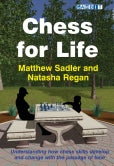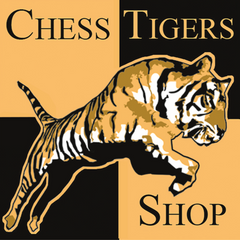
Sadler: Chess for Life
Autor: Sadler, Matthew
Verlag: gambit
Erscheinungsjahr: 2016
Sprache: English
Buchumschlag: book
Seiten: 240
In this thought-provoking, wide-ranging and often inspiring book, the authors examine how chess style and abilities vary with age. The conventional wisdom is that greater experience should compensate for a loss of youthful energy, but with so many of the world's elite currently in their twenties, chess is increasingly looking like a young man's game. By making a number of case studies and interviewing players who have stayed strong into their forties, fifties and beyond, the authors show in detail how players can steer their games towards positions where their experience can shine through. Interviewees include:
- GM John Nunn
- GM Yasser Seirawan
- GM Nigel Short
- GM Judit Polgar
- GM Keith Arkell
- GM Pia Cramling
- FM Terry Chapman
- GM Jon Speelman
- GM Sergei Tiviakov
- WIM Ingrid Lauterbach
By examining so many aspects of chess, the authors have written a work that ends up transcending its subject-matter, and becomes a text on how and why we love chess, the means by which we can play successfully whatever our age and level of play, and how chess is truly a game for life.
Matthew Sadler is one of the strongest British players of recent decades. Having become a GM in his teens, he twice won the British Championship and was awarded an individual gold medal at the 1996 Olympiad. After concentrating on an IT career for more than a decade, he returned to high-level chess in 2010 and quickly regained a spot in the world top 100. Matthew's struggles to bring his game back up to speed after his long break were part of the inspiration for this book. Natasha Regan is a Women's International Master from England who achieved a degree in mathematics from Cambridge University. While pursuing a successful career as an actuary in the insurance industry, she has raised a family and maintained a strong interest in chess and other board games, including Go.
“This book is what I have been looking for… I heartily recommend it” – David Nastasio , CHESS NEWS & VIEWS
“ Chess For Life is unlike any other chess book I have seen. It addresses the subject of how to sustain, and seek to improve, one's chess strength throughout life, despite the inevitable diminution of calculation ability. Sadler and Regan have produced an insightful analysis of the way chess players of different styles adapted to age and the advancement of theory. From this , and candid interviews of several retired players, they unveil a tour de force of ideas to consider applying to one' s own game. This is not a book for the aging – it is rather a testament to the value of experience with lessons for players of all ages” – Ross Jackson , NEW ZEALAND CHESS
“Through Sadler's and Regan's analysis of their role models' openings over time, readers learn what makes an opening repertoire ideal for longevity. Sadler and Regan also present tips for training and give practical approaches for succeeding at the board. Chess for Life is also enjoyable for readers, like me, who don't want to work hard. My favourite parts were the interviews with the role models, some of whom I met or played against as long ago as the 1970s” – WIM Alexey Root , CHESS LIFE MAGAZINE
“In this thought-provoking, wide-ranging and inspiring book, the authors examine how chess style and abilities vary with age. Nigel Short, for example, is the wrong side of 50 but remains in the world's top 150 players. There's an illuminating interview with him in the book. He still enjoys his chess and when asked for any tips for aspiring chess players he says that you have to love the game. I'll second that. I love the game and I love this book. In a world where many chess books are much the same, this is refreshingly different, thought-provoking and actually very useful. Well done Sadler and Regan” – Carl Portman , CARLSPLANET
“ Chess for Life , by a well-known Grandmaster and a Women's International Master with a strong background in statistics and gaming, has plenty to say about how veteran players can use their experience to compensate for a loss in youthful energy. A book that can be read with interest by many players (not only those over 40!) for those rated 2000 on up” – IM John Donaldson
“The subtitle of Matthew Sadler and Natasha Regan's Chess for Life is 'understanding how chess skills develop and change with the passage of time.' It is also fairly illustrative of the book as a whole. In a series of interviews with, and case studies of, “older” chess players, Sadler and Regan have written a thought-provoking and useful book for players of all ages.
Sadler is a superlative chess writer and his analytical powers are on full display in Chess for Life . The study of Pia Cramling's openings, for example, is a clear, concise dissection of how one builds a 1.d4 repertoire and how one tweaks it over time. The analysis of Tiviakov's 3…Qd6 Scandinavian is painfully thorough. The discussion of Capablanca's games – sadly the third World Champion could not be conjured for an interview – is as inspirational for us as Capablanca's games were for Sadler.
The real star of Chess for Life is Keith Arkell; or, better put, Arkell as seen through the lens of Matthew Sadler. Sadler sifts through hundreds of Arkell's games and teases out two key themes: his mastery of the Carlsbad Structure and his love of rook and pawn endings. In both cases Sadler does a superlative job of distilling the fundamentals of Arkell's play and rendering them comprehensible for his non-GM readers” – John Hartman, https://chessbookreviews.wordpress.com
“…hits a new target for chess literature. The authors present a series of case studies on “players who have stayed strong into their forties, fifties and beyond.” This is an excellent and original book that can be absorbed on several different levels, from adopting the role model's methods to suit one's own game to simply enjoying the new interviews. “Highly recommended.” – Sean Marsh, CHESS MAGAZINE
“A brilliant chess guide from Matthew Sadler and Natasha Regan, with in depth analysis, interviews, and statistics covering chess activity and results. As far as I am aware, this is the first book for experienced players considering a comeback to chess after a break. And there is more for players who are looking to revamp or expand their opening repertoires. As well, of course, for those who are simply chess lovers interested in a good read” – John Elburg, chessbooks.nl
“How do chess skills change with advancing years? Can you still win after the age of 40? Matthew Sadler and Natasha Regan address these intriguing questions in GAMBIT's latest book Chess for Life . Can accumulated experience hold out against the youthful enthusiasm of the database generation? Can you steer the game into channels in which experience is an advantage, especially the endgame? Before we go any further, I just want to make clear that this book is interesting for all chess players, not just those on the wrong side of 40!
Through interviews with well-known older players such as Short, Nunn, Speelman and Tiviakov, we learn a lot about the problems mentioned above, but also about something we should never forget: chess remains a fascinating game for players of all ages and of all strengths. . Sadler may well have got involved in this unique book because he himself stopped playing chess for 10 years – how do you get back up to speed after a break like that? Another interesting question is whether it is sensible and enjoyable to always play the same openings. Those who like playing through annotated games will also not be disappointed.
If I had more space, I would love to describe all the other aspects of the book, but for now I'll end with this: buy this book, you won't regret it!” – Bab Wilders, Dutch Daily
“ Chess for Life by Matthew Sadler and Natasha Regan is a very special book because of its content, form and author's background. The authors explore and deeply research how chess skills develop and change over time, following thirteen players (or fourteen if we include Sadler in this list). The central point of the book is to show how the role models adjust their approach to chess, to stay competitive after passing forty years of age. The authors pour their experience into the book, not only the sweet wins, but the bitter defeats.
I enjoyed the fact that part of the book is a follow up of Sergey Kasparov’s book Understanding the Scandinavian . A chunk of Chess for Life is devoted to Sergey Tiviakov, and the authors explain how Tiviakov uses the 3…Qd6 Scandinavian as a major point scorer, despite the lack of surprise. Several of Tiviakov’s games with the Scandinavian 3…Qd6 are annotated with explanations why Tiviakov is so successful beating low and high rated chess players in open tournaments. In summary, Chess for Life is a good read and the authors successfully made a connection with me as a reader. “Recommendable!” – Miguel Ararat, www.gainesvillechesstraining.com
“A very interesting book by Matthew Sadler and Natasha Regan. Chess for Life raises the question of how to be successful in chess even in old age. This was particularly relevant to Matthew Sadler, when he wanted to start in 2010 after 11 years of abstinence from chess. The British grandmaster, whose highest Elo before the break was 2667, did not want to embarrass himself, and as told in the book, he prepared for his comeback. This was obviously successful, because at the moment his Elo stands proudly at 2670. But the book is not just about him – 13 personalities of chess are examined to show there can still be celebrated successes in old age. Those living were interviewed and explained their motivation and the basis of their success. In addition, there is also a chapter each on José Raúl Capablanca and Tony Miles. A strong buy recommendation for anyone who wants to improve or get into the chess world again” – IM Dirk Schuh, ROCHADE EUROPA
Leseprobe
Sichere Zahlungsoptionen bei uns im Shop
-
Versand mit DHL und DPD
-
Versandkostenfrei in DE ab €50
-
14 Tage Rückgaberecht












